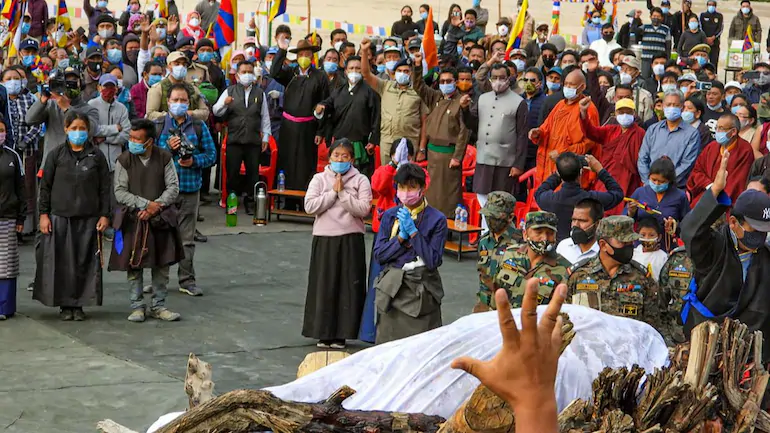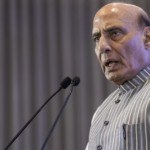
SOURCE: INDIA TODAY
any unpleasant firsts have happened along the India-China Line of Actual Control (LAC) in Ladakh in the last few months. Soldiers lost their lives in adversarial military action for the first time since 1975. First bullets have now been fired — officially described as warning shots — in 53 years.
A unit of the Special Frontier Force (SFF) was used for the first time in a military standoff with China. A soldier of the force died in the region. However, the actual circumstances leading to his death remain unclear. It has emerged that his death was caused by accidental stepping over an old – possibly from 1962 – landmine and not in the combative engagement with the Chinese troops.
The SFF comprises of ethnic Tibetan soldiers and the announcement of the soldier’s death was made by a member of Tibetan Parliament-in-exile. His funeral performed on Monday has become a talking point to the extent that a question is being asked if the Narendra Modi government is revisiting India’s stand on the One China policy.
ONE CHINA POLICY AND INDIA
One China policy is a position enforced by the Communist Party of China (CPC) that rules the country. After it occupied mainland China in 1949, pushing out then ruling Koumitang Party to Formosa, now known as Taiwan, the communist regime came up with One China policy.
It staked claim on a much bigger territory of Tibet, then under a Buddhist order government with practically no military, besides Taiwan. China occupied Tibet by 1950 and consolidated its military stranglehold on the region through the decade. It has been aiming to capture Taiwan since then but in the face of global opposition, China has not dared to carry out its designs across the Formosa Strait in the South China Sea.
India was among the first countries to recognise communist rule in China. Through the 1954 Sino-Indian Trade Agreement, India also acknowledged Chinese control of Tibet. However, the Chinese invasion of India in 1962 reneged on this accord.
India’s support to One China policy remained in limbo until 2003. It was during this intervening period that China built its south Tibet claim over Arunachal Pradesh.
In 2003, then Prime Minister Atal Bihari Vajpayee – heading another BJP-led NDA government – signed a joint declaration with his counterpart Wen Jiabao in Beijing. This declaration recognised that the Tibet Autonomous Region is part of the territory of the People’s Republic of China. It can be read here on MEA’s website.
ARUNACHAL: CHINESE RHETORIC AND ACTION
India’s recognition came in the view of Chinese acceptance of Sikkim as an Indian state, and without a change in its official position on Arunachal Pradesh. The Chinese claim is rhetorical and only a bargaining chip.
This is obvious from the fact that in 1962, when its army had reached up to Tezpur in Assam, it returned to the pre-1962 position along almost the entire eastern sector including Arunachal Pradesh, for which Beijing only yesterday reiterated its south Tibet barb.
It is not clear what has led China to needle India along the borders and the LAC in Ladakh. China would never tell anybody outside whether its provocation along the LAC is a diversionary tactic for its domestic audience, a reaction to global anti-China sentiment, an attempt to bulldoze investigation into the origin of Covid-19, or part of some larger geo-strategic game-plan. One thing that looks certain on the Indian side is that it is not business as usual with regard to China.
MODI GOVT ON A DIFFERENT PATH?
India has shunned its reluctance in becoming a player in the South China Sea-Pacific region and given a strong push to its counter-China engagement with already “distressed” partners in the East and Southeast Asian regions. It is also ready to revitalize the Quad — a grouping of India, Australia, the US and Japan as a force to counter Chinese manipulations in the region.
India has sent feelers that it is ready to deepen its engagement with Taiwan, something that China does not want. Against this backdrop came the decision to deploy the SFF in a pre-emptive strategic operation in an active military zone along the LAC. It was topped by Ram Madhav — an influential BJP general secretary — attending the funeral of the soldier, Nyima Tenzin.
Ram Madhav is considered a strong voice and an influence in shaping BJP’s and hence the government’s foreign policy dimensions. Ram Madhav posted a tweet confirming that Nyima Tenzin “a Tibetan who laid down his life protecting our borders”.
His tweet indicated that the use of ethnic Tibetan against the Chinese was not a one-off instance but could be a part of a policy of keeping the Tibet a reminder in bilateral “business” with China.
Ram Madhav’s tweet also read that the sacrifice made by the ethnic Tibetan soldier “would bring peace along the Indo-Tibetan border”. However, he deleted his tweet later. Some experts explained his act of deleting the tweet as a step to avoid “unnecessary publicity” of the SFF and its Tibetan link.
Does it indicate that the Modi government is resorting to the same bargaining chip strategy that was adopted by China over the Tibet versus Arunachal Pradesh equation? Will India send clearer signals for the first time that the One China policy, which automatically placing Tibet under Beijing, is under review?
After all, among other firsts, India physically occupied a few hilltops for the first time in Pangong Tso region recently.






